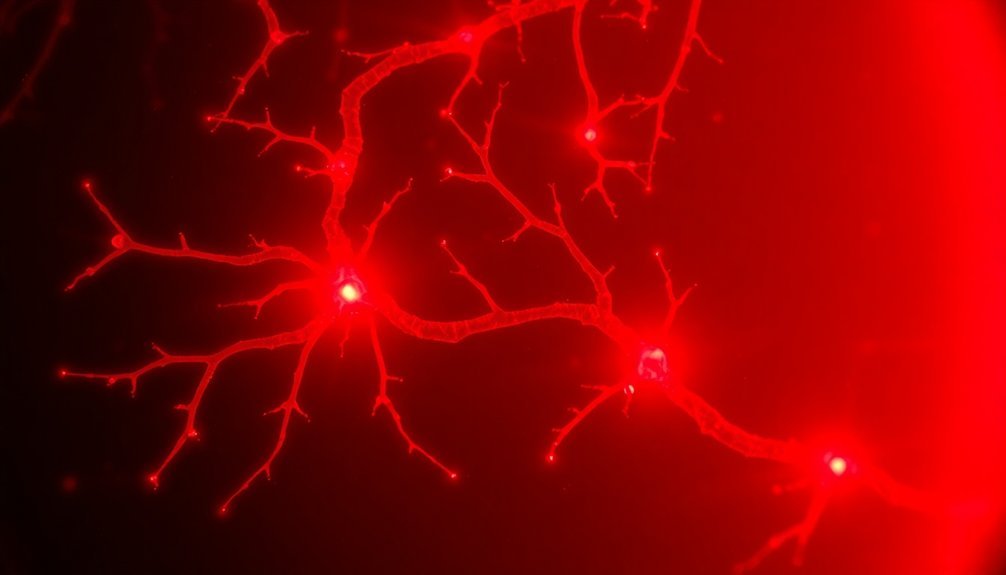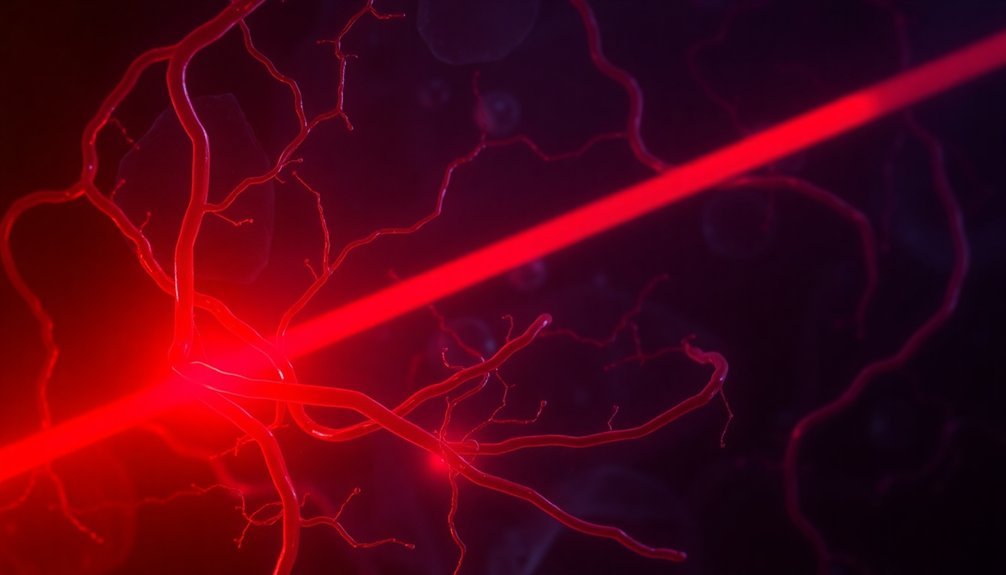Red light therapy can help restore your damaged blood flow in three key ways. First, it triggers your body to release nitric oxide, a molecule that naturally dilates blood vessels and improves circulation throughout your tissues. Second, it stimulates angiogenesis – the formation of new blood vessels – by increasing endothelial cell metabolism and boosting growth factors that support healing. Third, it enhances your cellular energy production by optimizing mitochondrial function, which powers the repair of damaged blood vessels and surrounding tissues. These mechanisms work together to create a thorough healing response that's worth exploring in more detail.
Nitric Oxide Release

The orchestration of blood flow through the human body relies heavily on nitric oxide (NO), a crucial signaling molecule that regulates vascular function.
When you need your blood vessels to dilate, NO binds to specific proteins called soluble guanylate cyclase, triggering a cascade of events that relaxes your blood vessels and improves circulation.
Your body produces NO through specialized enzymes called nitric oxide synthases (NOS), which come in different forms throughout your tissues. Research shows that blocking these enzymes with L-NMMA reduces flow by approximately 25% in healthy individuals.
When you're exercising or under stress, NO release helps maintain proper blood flow by preventing excessive constriction of your blood vessels.
If you're experiencing endothelial dysfunction, where your blood vessels can't dilate properly, it's often due to impaired NO production.
You can boost NO availability through therapeutic approaches like NO inhalation, which delivers this molecule directly to your bloodstream.
Once there, NO transforms into various bioactive forms, including S-nitrosothiols and nitrite, which help maintain vascular health.
For those with cardiovascular or neurological conditions, treatments targeting NO pathways offer promising solutions for improving blood flow and reducing vascular resistance.
Deep Tissue Vessel Formation
Frequently overlooked in tissue repair, deep tissue vessel formation plays a vital role in restoring damaged blood flow through red light therapy's remarkable effects.
When you undergo red light therapy, it stimulates angiogenesis – the formation of new blood vessels – which promotes healing throughout all four phases of the wound-healing process.
Your body responds to red light exposure by increasing endothelial cell metabolism and boosting vascular endothelial growth factor (VEGF). This enhancement leads to improved blood flow and better tissue oxygenation.
The therapeutic wavelengths penetrate up to 2 millimeters deep into your skin to effectively reach underlying tissues.
You'll also experience increased fibroblast activity, which is essential for collagen synthesis and tissue repair.
Red light therapy at 650 nm markedly increases capillary formation while promoting nitric oxide generation and calcium influx in your endothelial cells. It's particularly effective if you're dealing with conditions where low oxygen flow impairs healing, such as diabetic wounds or post-surgical recovery.
You'll benefit from enhanced microcirculation and activated anti-inflammatory responses as the therapy supports your body's natural healing mechanisms. This process improves oxygen delivery to affected areas, making it an effective treatment for various conditions, from arthritis to muscle sprains.
Cellular Energy Production

During cellular energy production, your mitochondria serve as microscopic powerhouses, converting nutrients into ATP through a complex series of biochemical reactions.
Your cells initiate this process through glycolysis, breaking down glucose into pyruvate molecules while generating 2 ATP and 2 NADH. The resulting pyruvate then enters the mitochondria, where it's transformed into acetyl-CoA for the citric acid cycle. Several B vitamins are essential for these energy-producing reactions to occur properly.
You'll find that the citric acid cycle processes this acetyl-CoA to create high-energy electron carriers, which fuel the electron transport chain. This chain generates a proton gradient across your mitochondrial membrane, enabling ATP synthase to produce most of your cellular ATP.
When you're functioning normally, your cells use 100-150 moles of ATP daily to power essential processes like muscle contraction and nerve impulse transmission.
Your body can also produce energy through alternative pathways. When glucose isn't available, you'll rely on beta-oxidation to break down fatty acids, or ketosis to metabolize ketone bodies. Both processes ultimately feed into the citric acid cycle, ensuring you maintain a steady ATP supply for cellular functions.
Frequently Asked Questions
How Long Does Each Red Light Therapy Session Typically Last?
Your red light therapy sessions will typically last between 10 to 20 minutes, depending on your treatment goals. You'll want shorter sessions when starting out, and longer ones for chronic conditions or deeper tissue treatments.
Can Red Light Therapy Be Harmful to People With Light-Sensitive Conditions?
Yes, if you're light-sensitive, red light therapy can be harmful. You'll need to consult your doctor first, as it may cause skin irritation, blistering, or eye damage. Always start with short sessions under supervision.
Is Red Light Therapy Safe to Use With Blood-Thinning Medications?
You should be cautious using red light therapy with blood thinners. It's best to consult your doctor first, as there's evidence that the therapy might affect blood clotting and interact with your medications.
What Areas of the Body Should Be Avoided During Treatment?
You should avoid using red light therapy on recent burns, malignant cancers, thyroid areas, and your eyes. Don't treat areas with metal implants, radiation therapy zones, or your abdomen if you're pregnant.
How Soon After Treatment Can Patients Expect to See Initial Results?
You'll notice immediate relaxation after your first session, with visible skin improvements in 1-2 weeks. For chronic conditions like pain or deep tissue issues, expect noticeable results within 4-12 weeks of consistent treatment.
In Summary
You'll experience improved circulation through red light therapy's three key mechanisms. By triggering nitric oxide release, you're enabling better blood flow throughout your body. You're also stimulating the formation of new blood vessels deep within your tissues. Finally, you're boosting your cells' energy production, which helps repair and regenerate damaged blood vessels. These combined effects make red light therapy an effective solution for circulation problems.





Leave a Reply